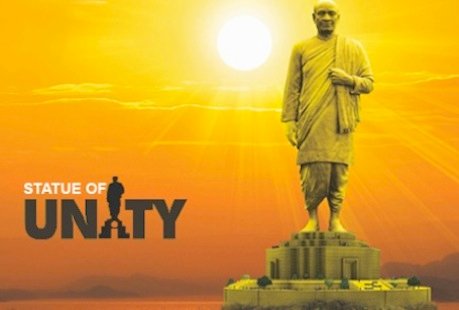Cheap spaceships, expensive statues and a race for power
 The pristine sky and man’s yearning to explore the galaxies and planets that embellish it make an unlikely backdrop for a very murky controversy back on Earth. Here, the Bharatiya Janata Party (BJP) and the ruling Congress Party are in a death-lock struggle for power in the 2014 general election.
The pristine sky and man’s yearning to explore the galaxies and planets that embellish it make an unlikely backdrop for a very murky controversy back on Earth. Here, the Bharatiya Janata Party (BJP) and the ruling Congress Party are in a death-lock struggle for power in the 2014 general election.
The Indian Space Research Organization this month launched a $56 million satellite that, hopefully, will rendezvous with Mars sometime in September 2014, looking for traces of the fiery methane gas that could indicate life on that planet.
The government was perhaps also hoping that this triumph of Indian science and technology would take people’s minds off such mundane things as terrorism, corruption, the rising prices of tomatoes, potatoes and onions, and continuing poverty in the deep countryside.
It is about the cheapest space mission by any country ever, and has earned ISRO and India the grudging respect of scientists from the UK, Europe and some in NASA too. At home, the reactions have been mixed, with at least one major voice, former ISRO chief G. Madhavan Nair calling it a farce without any scientific merit. Others of a socialist mien have termed it a waste of money that could have gone to feed the poor, or set up some hospitals.
But while there is some noise over the expensive business of space exploration, there has been a stunning silence in the country over a project 10 times more expensive, the approximately $600 million proposal to erect a statue of the late “Sardar” Vallabhai Patel. He was a minister in the cabinet of the prime minister Jawaharlal Nehru at independence, and had the responsibility to “persuade” the maharajas, princes and nabobs of the many small states, fiefdoms and principalities to accede to the newborn Union of India.
Many did so willingly. Others, such as the ruler of Hyderabad, the richest man on Earth at that time, succumbed only after the Indian army defeated his in a brief but brutal battle. Such valor earned Patel the nickname of Iron Man and consolidated his other title, Sardar, Leader of Men.
Patel has a controversial political legacy. Like Nehru, he worked closely with Mahatma Gandhi and perhaps even harbored prime ministerial ambitions. Gandhi favored Nehru as the more widely acceptable leader with a vision for the new nation.
Many historians think one argument that weighed against Patel was his perceived fondness for the Hindu community and a suspicion of Muslims.
It is perhaps these qualities – a firmness of purpose which saw no harm in use of massive force, and a majoritarian view – that has made Patel, a congressman, such a hot favorite of the ultra nationalist Hindu elements.
For the record, Patel banned the Rashtriya Swayamsewak Sangh (RSS) for its involvement in the conspiracy that assassinated Gandhi in 1948, but later revoked the ban when the militant organization swore it would not indulge in politics.
Narendra Modi, the BJP’s prime ministerial candidate, fancies himself as heir and successor to Sardar Patel; his numerous fans honor him in giant posters as the new avatar of the great leader.
They call him Chhote Sardar, the Young Leader, and the New Iron Man. It helps that Modi, like Patel, comes from Gujarat. And just to cement this bond, Modi has laid the foundation stone of a $600 million iron statue of Patel in Gujarat. Named ther Statue of Unity, it is touted to be much taller than the Statue of Liberty in New York, and is being projected in a media blitz as the largest statue ever.
No one has objected to erecting it. Not even those who cavil at the $56 million cost of the satellite to Mars.
But now Prime Minister Manmohan Singh and several of his ministers are locking horns with Narendra Modi on the legacy of Sardar Patel. The confrontation has been savage, sometimes ugly. It has spilled onto the pages of the newspapers and consumed hours without number on India’s frenetic 24:7 news channels.
The Congress can say with much justification that Patel was a member of the party, worked closely with Mahatma Gandhi, and even though he disagreed with Nehru on seminal issues, was a loyal member of the cabinet for many years. And it can say Patel banned the RSS, spiritual fountainhead of the BJP.
And therein lies the point. The polarizing confrontation has split the Patel legacy. It is not Patel’s virtues in taking most people along with him, or his simplicity and work for the poor, especially the farmers of Gujarat, that Modi and his BJP covet, or want to own.
In their view, Patel’s relevance lies in his treatment of dissidence, his power play and determination to have his way in the face of all resistance, as in Hyderabad and several other states then ruled by Muslim nabobs. Nehru once in anger called Patel a ‘communalist’ for his alleged views on Muslims and willingness to use force against those of them who opposed Indian unity.
For the RSS-BJP, this is not a derisive term. This, they have no hesitation in saying, is the correct way, if not the only way, to handle Islamic terror and voices of protest.
Patel has become a metaphor in the handling of India’s volatile secular polity. The statue is but the pretext to carry this message across as much to the Hindu majority in India as to the religious minorities, specially the Muslims.
John Dayal is the general secretary of the All India Christian Council and a member of the Indian government’s National Integration Council.


 Votes : 0
Votes : 0









